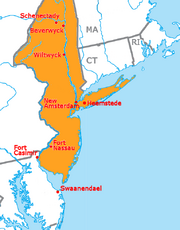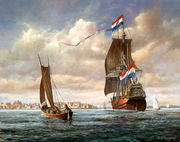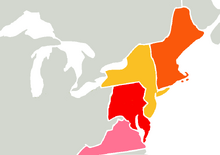| ||||||||
| Capital (and largest city) |
New Amsterdam | |||||||
| Other Cities | New Amstel, Fort Cassimir, Fort Altena and Fort Orange-Beverwijck | |||||||
| Language Official |
Dutch and Dutch Low Saxon | |||||||
| Others | French, English, German dialects, Swedish, Finnish, Northern Iroquoian languages, Algonquian languages, Dutch based pidgins (Jersey Dutch and Pidgin Delaware), and Dutch based creole (Mohawk Dutch and Negerhollands) | |||||||
| Religion Main |
Netherlands Reformed Church | |||||||
| Others | Other Protestant denominations, Catholicism, Judaism, native animistic beliefs and Longhouse Religion (Gaihwi:io) | |||||||
| Ethnic Groups Main |
European (Dutch, English, German, Finnish, Swedish, French) | |||||||
| Others | Native Americans | |||||||
| Government | Colony of the Dutch Republic administered by the Dutch West India Company (1614-1682), Generality Land of the Dutch Republic (1682 to date) | |||||||
| Legislature | Council of New Netherland (Raad van Nieuw-Nederland, 1675-...) | |||||||
| States General of the Dutch Republic | ||||||||
| Director General | Jacobus Van Cortlandt | |||||||
| Established | 1614 | |||||||
| Currency | Wampum beads, Dutch rijksdaalder and leeuwendaalder | |||||||
Tot handel, en tot scheepvaart,uitgezocht,
met havens, die den aard zelf heeft gewrocht
tot heul, van wie in ’t lijden wordt gebrocht
en raakt verlegen.
(Jacob Steendam, Lof op Nuw-Nederland, 1661)
The New Netherland (Dutch: Nieuw-Nederland, Latin: Nova Hollandica or Novum Hollandium) is colonial province (generality land) of the Dutch Republic located on the East Coast of North America. The claimed territories extended from the Chesapeake Peninsula to extreme southwestern Cape Cod. The principal settlements are on the islands of Manhattan and Long Iceland and along the rivers Hudson, Delaware and Connecticut.
It limits to the Northwest with the lands of Iroquois Confederacy (a Dutch protectorate since 1708), Northeast with the New England Confederation and Southeast with Maryland.
History

Settlements of New Amsterdam
The colony was conceived as a private business venture of the Dutch West India Company (WIC) to exploit the North American fur trade. During its first decades, New Netherland was settled rather slowly, partially as a result of policy mismanagement by the WIC and partially as a result of conflicts with Native Americans. The settlement of New Sweden, captured in 1655, encroached on its southern flank, while its northern border was redrawn to accommodate an expanding New England.
During the 1650s, the colony experienced dramatic growth and became a major port for trade in the North Atlantic and the Commonwealth colonies despite the restrictions of the Navigation Acts.
The Flushing Remonstrance of 1657 brought religious freedom against Stuyvesant and the will of English settlers of New Netherland. The directors of the WIC advised to end all acts of religious persecution and harassment were to be not officially sanctioned. All ordinances against it were repelled. Quakers, Baptists and others dissidents were allowed to preach and meet.
Although New Amsterdam gained full city rights in 1653, it did not stop the complains on the lack of same liberties as in the metropolis for the colony, economic freedom and the removal of the colony from the control of the WIC. Politics in New Netherland had three main factions: Governor's party, Localists party and the English party.
The Second Remonstrance of New Netherland is delivered to the Dutch States-General in 1673 demanding end of company rule and establishment the territory as a colony. This document starts the route to complete autonomy.
The first elections to the Council of New Netherland in 1675 gave a majority of its seats to the Localists, followed by the English party and the Governor's partisans. The Council voted a series of grievances that affected the colony and had not being addressed by the authorities. The chief one was free trade, followed by a more open policy of migration and colonization, lack of freedoms and abuses of the authorities.
In 1680, Willem III Prince of Orange as Stadtholder moves a motion to establish the colony of New Netherland as separate from the rule of the Dutch West India Company to the States-General. In 1682, under careful lobby of governor-general Anthonie Heinsius New Netherlands becomes a self governing colony with the same status as a Generality Land of the Dutch Republic, but with an elected assembly and director general named by the Stadtholder. The immediate effect is that all restriction for trade, migration and settlement in New Netherland are abrogated. Jews are allowed to settle permanently in New Amsterdam (with or without passports) along complete freedom of religion.
In 1724 Stadtholder Johan Willem Friso issues a New Charter of Freedoms and Exemptions based on a proposition of the Council of New Netherland. This charter takes most of its provisions from the British Claim of Rights Act of 1702.
Colonization

Ship arriving to New Amsterdam
The Patroonship plan of 1628 granted large tracts of land and gave the rights to the land as well as legal rights to settle all non-capital cases, quite similar to a manorial lord. In return the Patroon would agree to bring over settlers and colonize the land at his own expense. Additionally Patroons were allowed to trade with New England and Virginia and to engage in both the fur trade, subject to a company tax and could participate in the fish trade.
Under the Patroonship plan New Netherland expand with more colonists and settlements taking hold. The nerve center of New Netherland was along the Hudson River from New Amsterdam north-west to Fort Orange.
The North River Treaty
In March 1663 the Iroquois and Dutch West India Company (WIC) envoys meet at Fort Orange to sign the North River Treaty. This was the result of proposal by the WIC. After several month of negotiations both delegations meet to sign the Treaty and exchange gifts. The Treaty defined the relationship between both parties. The Dutch were giving open access to Iroquois and establish factorijs (trade posts), forts and schools, and the Iroquois given freedom of movement and commerce in New Netherlands and New Amsterdam. Exchange of food in case of scarcity and free trade between the two parties. The WIC guaranteed the supply of guns and munitions. Mutual recognition of the titles of the Iroquois plantoonships and Dutch purchases in Iroquois lands. both parties could buy and sell land in their territories. Finally each year at the same date the envoys would meet to exchange gifts, complains and suggestions. Legal issues would also be addressed in these meetings.
The Treaty Teantontalago / Mabee Fort of 1708
After the The Beaver Wars the Iroquois were in a dire situation due to diseases and reduction of population along the rearmament by the French of rival Iroquois tribes, This pushed the Haudenosaunee to establish alliances with the Dutch and English colonies. With the Dutch a closer alliance was signed by Treaty Teantontalago/Mabee Fort of 1708, becoming the Haudenosaunee a Dutch protectorate with a large degree of autonomy (New Netherland-Iroquois Condominium).
Government
The Director General (Directeur-Generaal) is in charge of the colony. The Director General was named by the Dutch West India Company from 1624 to 1682. After 1682 the office is named and responsible to the Stadtholder. The State Directory formed in 1685 to assist in its executive function the Director General, with part of its membership named by the Council of New Netherland.
- Director Generals
- ...
- Peter Stuyvesant (1647-1672, died in office)
- Wilhelmus Beekman (interim 1672-1673, 1673-1681)
- Military Commanders Admiral Jacob Binckes (1672-1674), General Anthonij Colve (1672-1678)
- Cornelius Van Steenwyk (1681-1687)
- Wilhelmus Beekman (1687-1700)
- Jacobus Van Cortlandt (1700-1722)
- Koenradd Van Rensselaer (1722-1730).
Until 1652 the Council of Nine Men, an elected citizens board in 1647, 1649, 1650 and 1652, advised the Director General. It became the basis for the municipal government when the city of New Amsterdam received its municipal charter in 1653. Beverwyck received its city rights in 1652. Nieuw Haarlem was formally recognized in 1658.
The Second Remonstrance of New Netherland is delivered to the Dutch States-General in 1673 demanding end of company rule and establishment the territory as a colony. Under pressure from the Dutch and English residents that demanded representation Beekman installed in 1675 the Council of New Netherland (Raad van Nieuw-Nederland), after consultation with the Heeren XIX who granted its permission. The Council would advice the Director General and approve in some cases matters or regulations brought to its consultation or by its own initiative. Its members would be elected from the cities and villages of New Amsterdam, Beverwyck, Nieuw-Amstel, Nieuw Haarlem and other important settlements. The Council of New Netherland gained full legislative powers in 1682 and the right to name part of the State Directory.
With the change of its status to generality land in 1682 not only New Netherlands gains complete autonomy but also has jurisdiction of all India affairs (i.e. relations with Iroquois Confederacy). With Iroquois it signed the Treaty Teantontalago (or Mabee Fort) in 1708 taking them under protection of New Netherlands and the Dutch Republic.
| |||||||||||||||||||||||



